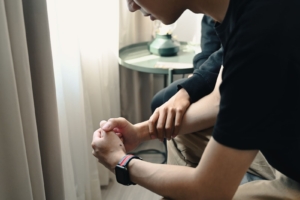The Benefits of Taking a Step Back
When facing a challenge, many people think it is essential to face it head-on. Whether a problem at work, a fear you struggle with, an argument with a spouse, or even a medical crisis, there are aspects that you need to see to swiftly. However, very rarely, are these problems so urgent that you cannot take a step back to regroup. Newport Beach Christian Counseling can support you in finding the space and tools you need to effectively navigate challenges in your life.
You may feel the urge to take action immediately in order to get to the other side of the issue. You may even feel pressure from someone else to address the situation immediately. Whether the desire to work through the issue is internal, stemming from something within you, or external, stemming from someone or something else, it is beneficial to think about whether you need to handle the problem immediately.
This is especially important to consider if it is a long-term issue. These problems may be difficult to manage over extended periods of time. Doing so can cause additional stress, anxiety, anger, or burnout that prevents you from making good choices.
Taking a Step Back
Instead of pressing forward, pause and ask yourself some questions:
- Does this problem need to be dealt with immediately?
- Am I in danger? Is anyone else in danger?
- Am I handling this well?
- Would I benefit from extra time to think through things?
- Do I need counsel from a trusted friend, pastor, or therapist?
Answering these questions can help determine if you need to address the issue right away or if you have the ability to take a step back. If someone is in danger, including yourself, it is essential that you make changes to ensure everyone’s safety.
For example, if someone is hurting you, it is important to remove yourself from danger. Similarly, if your child is being bullied, you need to make sure your child is safe before taking a step back to evaluate further.
If you are doing your best to navigate a situation, but find that you are not functioning well, it may be time to step back. Indicators like stress, anxiety, short-temperedness, procrastination, avoidance, and anger are indicators that you need space and support in whatever you are facing.
As you consider your specific situation, you can determine when and how to take a step back. Options may include:
- Taking a break from an argument
- Taking a mental health day from school or work
- Seeking counseling before addressing the issue further
- Doing something that calms you
- Practicing breathing exercises
- Praying
- Meditating
As you try these things, you will notice several benefits of taking a step back. They may not be immediate, but as you practice them, you can discover how helpful they can be.
Some noteworthy benefits that come with an intentional pause during a challenging situation include:
Seeing What’s Best for You
When you are close to a problem it can be hard to truly see what is best for you. Taking a step back can help you better understand the best path for you without the noise of other people’s opinions.
Taking Time to Heal
Struggling with conflict or crisis, whether personal, relational, or work related, generates countless opportunities for you to be hurt. The way someone treats you, the burden of prolonged stress, or the wounds of your past can leave you feeling vulnerable and broken. Taking a step back gives you time and space to heal.
Reflecting on Your Thoughts and Feelings
Sometimes something that starts small can spiral into a bigger issue. This happens frequently in many relationships. What started as a little disagreement can spiral into an intense argument or long-lasting grudge. This can make it particularly hard to truly consider your thoughts and feelings. Taking a step back gives you a chance to think. It allows you to look more objectively at how you feel.
Enjoying the Present Moment
 People rarely take time to enjoy things when life feels hard. It is easy to worry about how to move forward or stress about what is to come. This prevents you from enjoying anything in the present. Taking a step back gives space to be present and find joy in what.
People rarely take time to enjoy things when life feels hard. It is easy to worry about how to move forward or stress about what is to come. This prevents you from enjoying anything in the present. Taking a step back gives space to be present and find joy in what.
Seeing Another Perspective
People do not always see other perspectives when they are in the middle of a problem. It is easy to get stuck in your thinking, never considering things from another angle or thinking how another person may see the situation. When you take a step back, you can consider the problem from various angles. You can even ask God to help you do this.
Discovering Your Values
Identifying your values feels simple when you are not in the middle of a crisis, but things can change quickly when you are. It is easy for you to disregard the values you hold because you are busy trying to manage your overwhelming situation. Taking a step back gives an opportunity to look at what you value most and see how to move forward with that in mind.
Understanding the Bigger Picture
Rarely do people see the broad picture in the heat of a conflict. When a couple argues about doing the chores, it may seem like it is about laundry and mowing the lawn. In reality, it may be about something else. Perhaps one person is feeling overwhelmed with the demands on them. Maybe there are unmet expectations around chore sharing. Taking a step back can help people see what is actually beneath the surface.
Refocusing
It is always good to keep things in focus. In the middle of a crisis, it is easy to get hyper focused on certain things while losing focus of other things completely. Taking a step back will help you refocus on what is really happening and what is most important.
Finding Yourself
Problems have a way of making people lose themselves. Whether it is getting bogged down in a stressful work environment or drowning in the day to day of parenting, you can work so hard to get through a day that you lose track of your needs and feelings. When you take a step back you are available to rediscover the unique things that make you special.
Recharging
Struggle wears people out. It can make you tired, weary from trying to manage things or address the issue you are facing. You may notice it in other areas of your life. For example, when you are dealing with an issue at work, you may come home and snap at your roommate even though they did nothing wrong. Carrying problems is exhausting. Taking a step back is an effective way to recharge in order to return to your problem.
God Calls You to Step Back and Look to Him
Jesus instructs His people what to do when things feel hard. He wants you to come to Him. He promises hope and rest as you move forward.
“Come to me, all you who are weary and burdened, and I will give you rest. Take my yoke upon you and learn from me, for I am gentle and humble in heart, and you will find rest for your souls. For my yoke is easy and my burden is light.” (Matthew 11:28-30, NIV)
You Do Not Need to Do This Alone
Taking a step back can be hard. As you face obstacles, the idea of not acting right away can be scary. Talking to a counselor can make the process easier. A trained counselor can help you better understand your situation, help you address any urgent needs, and guide you as you take a step back.
Having a person walk this road with you is incredibly helpful. Call our office at Newport Beach Christian Counseling to connect with a counselor with experience relating to your unique needs. A counselor will support you as you find the best way to move forward.
“Blue petaled flowers”, Courtesy of Unsplash, Unsplash.com, CC0 License

 One of the effects of PTSD is on a person’s nervous system. Ordinary places like shopping malls or crowded venues like churches might suddenly trigger them. Certain smells, flavors, or sounds might make them jumpy or repulsed. They might even display symptoms of dizziness or clumsiness from time to time.
One of the effects of PTSD is on a person’s nervous system. Ordinary places like shopping malls or crowded venues like churches might suddenly trigger them. Certain smells, flavors, or sounds might make them jumpy or repulsed. They might even display symptoms of dizziness or clumsiness from time to time. Physical health issues are a reality for those who work in the healthcare industry. During the COVID-19 pandemic, they were on the front line and therefore more at risk for contracting the virus themselves. Those in the health profession are also more at risk of physical harm as they carry and attend to those in distress.
Physical health issues are a reality for those who work in the healthcare industry. During the COVID-19 pandemic, they were on the front line and therefore more at risk for contracting the virus themselves. Those in the health profession are also more at risk of physical harm as they carry and attend to those in distress. Surviving infidelity and remaining married requires work from both spouses. This may not seem fair to the hurt spouse at first. If you are the one who was hurt, you might feel that the other person should have to put in all the work to fix what they broke. This is a natural reaction to injustice.
Surviving infidelity and remaining married requires work from both spouses. This may not seem fair to the hurt spouse at first. If you are the one who was hurt, you might feel that the other person should have to put in all the work to fix what they broke. This is a natural reaction to injustice. Scripture offers many prayers to address grief in its many forms. One of the kinds of prayers in the Bible is lament. This sort of prayer can be helpful when a person is grieving. A lament is an honest, raw expression of our sorrows that’s directed toward God. It is an expression of your pain and a way to mourn loss. A sizable portion of the Psalms is made up of laments in various contexts.
Scripture offers many prayers to address grief in its many forms. One of the kinds of prayers in the Bible is lament. This sort of prayer can be helpful when a person is grieving. A lament is an honest, raw expression of our sorrows that’s directed toward God. It is an expression of your pain and a way to mourn loss. A sizable portion of the Psalms is made up of laments in various contexts. Guilt has its place in our lives because it helps us be aware that we’ve done something that we shouldn’t have done, or not done something that we ought to have done. This gap between our actions and our ideals can drive us to act to rectify the deficiency. To address your guilt, the best way is to act, by seeking to undo what was done, to try and make amends, as well as to apologize for any harm caused.
Guilt has its place in our lives because it helps us be aware that we’ve done something that we shouldn’t have done, or not done something that we ought to have done. This gap between our actions and our ideals can drive us to act to rectify the deficiency. To address your guilt, the best way is to act, by seeking to undo what was done, to try and make amends, as well as to apologize for any harm caused. The fact that you’ll be moving is obvious enough, but what isn’t always obvious is why. Take the time to explain to your children, at an age-appropriate level, the reasons for the move, and then take time to listen to their concerns. Validate any concerns that they have and address these as honestly as you can. Give them room to express themselves, whether by talking, drawing, or writing.
The fact that you’ll be moving is obvious enough, but what isn’t always obvious is why. Take the time to explain to your children, at an age-appropriate level, the reasons for the move, and then take time to listen to their concerns. Validate any concerns that they have and address these as honestly as you can. Give them room to express themselves, whether by talking, drawing, or writing. Massage is a great way to relax the body. Treat yourself to a 30- or 60-minute massage. It can be exactly what the body needs to calm itself down naturally. Not only does massage help calm inflammation throughout the body, but it also resets both the sympathetic and parasympathetic nervous systems.
Massage is a great way to relax the body. Treat yourself to a 30- or 60-minute massage. It can be exactly what the body needs to calm itself down naturally. Not only does massage help calm inflammation throughout the body, but it also resets both the sympathetic and parasympathetic nervous systems. Obsessions are repetitive, involuntary, fear-producing, thoughts that the child does not want to have but cannot stop thinking about or control, and that can have a paralyzing effect that prevents him or her from thinking about anything else.
Obsessions are repetitive, involuntary, fear-producing, thoughts that the child does not want to have but cannot stop thinking about or control, and that can have a paralyzing effect that prevents him or her from thinking about anything else. Go for a boat ride
Go for a boat ride